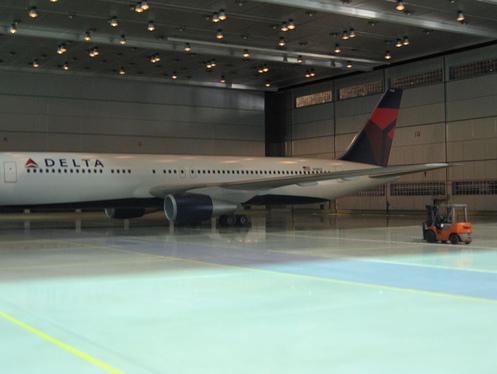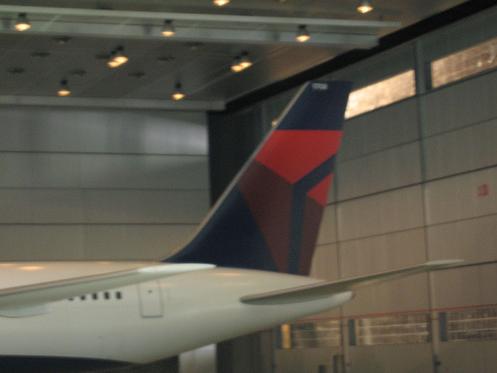NATO just painted one of their Boeing E-3A Sentry (707-300) in special 25 years anniversary livery. Very nice livery if you ask me 🙂
(You need to activate Javascript in order to view the photo)
NATO just painted one of their Boeing E-3A Sentry (707-300) in special 25 years anniversary livery. Very nice livery if you ask me 🙂
(You need to activate Javascript in order to view the photo)
The Marine Corps announced Friday the V-22 Osprey will see action in Iraq in September when it will be deployed for seven months to help move troops and equipment. Gen. James T. Conway, commandant of the Marine Corps, made the announcement in the Pentagon, in what was called a historic move for the Marines.
The Osprey, manufactured jointly by Textron’s Bell Helicopter in Texas and Boeing in Ridley Township, will be the first tilt-rotor aircraft used by the military. The Osprey can take off and land like a helicopter, tilt its rotors and then fly like an airplane.
The aircraft has been much-maligned for operational test failures over the years, including two fatal flights in 2000, but has the capabilities to fly faster, farther and higher than the CH-46 Sea Knight it is replacing.
Marine Medium Tiltrotor Squadron 263, or VMM-263, which consists of 171 officers and Marines, will operate 10 Ospreys — known as the MV-22 in the Marine Corps.
“The commander had decided this is where the greatest need for this capability is,” said Lt. Col. Scott Fazekas, spokesman for the Marines, explaining the decision to deploy the aircraft to Iraq.
Fazekas said he has not spoken with the pilots who will be flying the V-22 in Iraq, but he has “spoken to several people who have flown the V-22 and they have every confidence in the aircraft.”
The Marines also said VMM-263 could use the Osprey to conduct casualty evacuations or liaison work in a combat environment.
Boeing spokesman Jack Satterfield said the company had expected the aircraft to be used in Iraq because of its improved capabilities.
“I think everybody who’s worked on the program is probably quite proud of the fact that the aircraft is actually going into an operational theatre,” Satterfield said. “I think everybody who has worked on it..ill expect it to do extraordinarily well.”
This will be the very first use in combat for the MV-22 Osprey.
Source zwire.com
Following timely completion of the cabin installation of the first A380 for Singapore Airlines, Airbus has started the paintwork on this aircraft. The A380 will stay about three weeks in the company’s paint-shop in Hamburg/Germany. In addition to the actual painting, most of the other work in the paint-shop is cleaning, grinding, masking and unmasking the 3,100 square metres of surface of the A380.
About 3,600 liters of chromate-free paint is used for three layers of paint (primer, customer-paint, top-coat) for an A380. Only 600 to 1,000 kg of paint stays on the aircraft. Each layer is only measuring about 0.120 mm and is able to withstand differences in temperatures of about 100 degrees Celsius.
Airbus is applying the most modern and environmental friendly techniques for the A380 painting process. Electrostatic pistols are used to minimize paint mist. Used air is cleaned and washed through a multi-stage cleaning process to ensure that paint particles are disposed separately.
A380 launch customer Singapore Airlines is to take delivery of its first A380 in October this year.
Ryanair intends to launch a no-frills long-haul airline around the turn of the decade serving five or six US cities from its 23 European bases and offering fares as low as $12.
The new carrier will operate independently of Ryanair with its own executives and board and a different name and buy a fleet of up to 50 Airbus A350s or Boeing 787s at a time when chief executive Michael O’Leary expects prices to dip following the current surge in orders.
With “the cheapest fare €10 ($12)”, O’Leary expects the services, to secondary airports such as Baltimore, Providence in Rhode Island and New York Long Island Islip Macarthur “to be full”. He expects sales of food, drink, duty-free goods and in-flight entertainment to be a major revenue earner.
However, the new airline will have a “premium class” pitched against “the best in the business” such as Virgin Atlantic.
Read the full article on: http://www.flightglobal.com/articles/2007/04/11/213208/ryanair-boss-michael-oleary-plans-launch-of-transatlantic-no-frills-airline-with-fleet-of-50.html
Delta Air Lines unveiled a new, boring, livery.


As it nears the end of its bankruptcy case, Delta Air Lines is preparing to roll out a new paint scheme for its jets — the third such repackaging in 10 years.
Delta is expected to unveil the new livery soon after its scheduled emergence from Chapter 11 at the end of this month. The airline isn’t saying much officially, other than to acknowledge a new paint job might be in the works as part of a larger post-bankruptcy marketing campaign.
Chief Executive Gerald Grinstein “has mentioned that it’s something that we’re looking at,” Delta spokesman Jeff Battcher said.
But word of the project has circulated around Delta and on aviation Web sites such as flyertalk.com and airliners.net.
The main feature of the new design is likely to be the return of Delta’s triangular shield logo, known as “the widget,” to the tail of its jets, according to one employee familiar with the design.
He said a working version features an all-red version of the logo on navy blue tails. The triangular logo — currently red, white and blue — also gets a new three-dimensional look but doesn’t change its basic shape, the employee said. Aircraft colors will also be tweaked, featuring a darker blue that matches recently-revamped employee uniforms, while the main fuselage color will remain white.
Big jets are flying billboards, so airlines take paint schemes seriously. Different managements also use them to put their stamp on a company or as part of broader “re-brandings.”
The current Delta design, with its wavy color bands draped across a logo-less tail, rolled out in 2000 during ex-CEO Leo Mullin’s tenure. One of Mullin’s lieutenants termed it “sophisticated and fluid,” although some wags have termed it the “beach towel” look.
…
Delta has sought to involve employee groups such as the Delta Board Council, which represents employees at meetings of the carrier’s board of directors.
Not long after he stepped in as CEO in 2004, Grinstein returned to Delta’s traditional widget logo because employees objected to a subtly re-designed version that Mullin had introduced.
But at the time, he professed little interest in a new paint scheme.
“If there’s one thing I’m not going to fiddle with now,” he said at the annual shareholders meeting that year, “it’s the livery of the aircraft.”
Source: http://www.ajc.com/business/content/business/delta/stories/2007/04/06/0406bizdelta.html
Since Airbus announced yesterday the cabin furnishing for the first Singapore Airlines Airbus A380 is completed, you might be interested in seeing this newly designed cabin.
UPDATE: Visit SIA A380 Cabin Interior Revealed – Pictures
Unfortunately there are no photos out yet, but I found a page featuring the new cabin design concept.
Cabin furnishing of the first production A380 was completed in early April and is being tested prior to final delivery to Singapore Airlines.
The first production A380 – MSN003- due to enter service with Singapore Airlines later this year, reached the end of the cabin systems test phase on 4 April. Installation of the aircraft’s cabin at the A380 final assembly line in Hamburg was finished on 21 March and since then Airbus’ engineers and systems specialists have been performing a range of tests on the newly installed systems to check that they are working as expected.
The A380 programme team has been working with Singapore’s three on-site representatives throughout cabin furnishing to ensure that they are closely involved in decisions at every stage. And from 5 to 10 April, 30 representatives of Singapore Airlines including senior management are visiting the FAL to gain a comprehensive overview of the aircraft and its cabin systems as part of the customer pre-acceptance phase.
This phase of production has run very smoothly and, while details of the cabin remain secret, those working on the FAL are excited by the results achieved. “We are entering a new world of cabin furnishing,†said Peter Hahn head of the A380 FAL in Hamburg. “This cabin interior looks fantastic and brings a brand new dimension to the onboard experience that Singapore Airlines can offer its passengers.â€
Once the pre-acceptance phase has been completed, the aircraft will be painted in the Singapore livery and undergo more systems analysis on the ground before its cabin first flight in the summer to test cabin system performance in the air.
Source: airbus.com
John Travolta was forced to make a landing in Shannon/Ireland on Monday while piloting his private classic Boeing 707 airliner from Munich/Germany to New York. The actor, who was jetting back to the US after promoting his new movie in Germany, landed safely after his Boeing 707 suffered an engine failture mid-flight. Nevertheless, the 53-year-old just hired another plane and completed the journey, while his jet was grounded for repairs.
LTU just renewed it’s livery. It’s now seen the first time on their brand new Airbus A330!
(If you don’t see the photo, you need to activate Javascript)
A fiery object that nearly hit a Sydney-bound airliner over the Pacific may have been a meteorite or debris from a Russian satellite, New Zealand authorities say.
The Lan Chile A340 Airbus was flying between Santiago and Auckland, before heading to Australia, when it came within about 30 seconds of hitting the object about 10pm on Tuesday.
The pilots radioed air traffic controllers in New Zealand to report fiery objects falling in front and behind the plane.
Ken Mitchell from Airways New Zealand said the pilot reported the debris was falling “very close” to the plane.
“The pilot estimated the debris to be falling as close as five nautical miles (9.26 kilometres) to the aircraft,” Mitchell said.
“Certainly, a meteorite has not been ruled out and a formal investigation will determine that,” he said.
A plane spotter listening to a high-frequency radio broadcast told Fairfax media the pilot reported that a rumbling noise from the falling debris was louder than the plane.
The pilot also saw a piece of debris that lit up as it fell to earth.
Mitchell said the debris’ most likely origin was from a Russian satellite that had been decommissioned and fell to earth ahead of schedule.
He said the satellite was due to re-enter the earth’s atmosphere between 10.30am and noon on Wednesday.
“Around 10pm on Tuesday night we received notification from a Lan Chile flight enroute from Santiago to Auckland that he was experiencing what appeared to be falling space debris,” Mitchell said.
According to the Lan website, the A340 Airbus typically cruises at 976km/h, meaning the debris would have fallen just 34 seconds away from the aircraft.
The aircraft holds a maximum of 271 passengers.
Bill Sommer from New Zealand’s Civil Aviation Authority said there would be an investigation into the incident.
He said he was aware of reports that NASA had thought the falling satellite was not responsible and that a meteorite was most likely to blame for the incident.
An Aerolineas Argentinas aircraft flying enroute from Auckland to Argentina was notified of the debris, but elected to continue with the flight, Mitchell said.
“We have compiled a formal incident report and we will be filing that with our Aviation Safety Authority here in New Zealand in the next day or two,” he said.
A person from Lan Chile who answered a call to the company’s Auckland office today said information about the incident was confidential.
Source: http://www.brisbanetimes.com.au/articles/2007/03/29/1174761624562.html